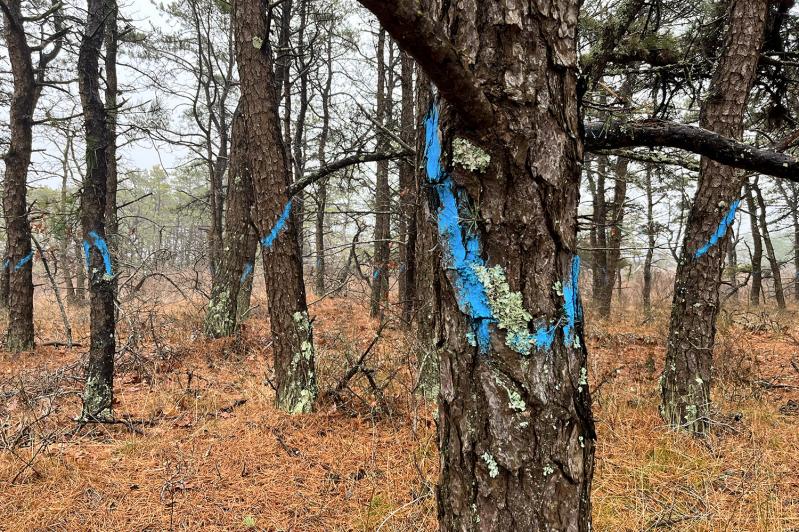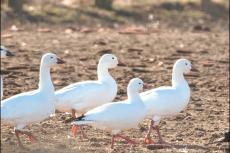The bright blue slashes of paint stand out like neon under a black light, marking the trunks in a stand of healthy pine trees along both sides of Cranberry Hole Road near Napeague Meadow Road as you’re heading toward Lazy Point. Those trees have a cinematic kind of destiny: They will be sacrificed to protect the overall health of the region’s forests as the southern pine beetle continues its destructive eastward march.
East Hampton Town estimates that the invasive pine beetle, which appeared here as early as 2014 but began making front-page headlines in 2017, according to The Star’s “Nature Notes” column and general archives, has claimed as many as 60,000 trees on both public and private lands so far. The exact impact of the infestation has been hard to tally because town officials have not had complete access to private lands.
This month, forestry professionals from the New York State Department of Conservation are expected to descend on Napeague with chain saws to put some distance between uninfected trees and those already claimed by the invasive beetles. The town trustees signed off in December on this plan, which involves the D.E.C. stepping onto trustee-owned land to cut down the trees.
“They want to wait for cold temperatures when the beetles are definitely not active — removing some dead trees, removing infected trees, and they’re going to be removing live, healthy trees,” Jim Grimes, deputy clerk of the trustees, said by phone this week. “Hopefully by creating a healthier forest situation, it will either slow down or arrest the spread of the insect.”
In a statement, the D.E.C. said pine beetles have been “very active” in recent months. The approach of cutting healthy trees is “preventative thinning in overstocked pine forests to make stands more resilient/less susceptible to [southern pine beetle] attacks.”
“The pitch pines in Napeague State Park and east to Montauk currently require immediate action,” the D.E.C. continued in its statement. “The infestation in Napeague State Park expanded exponentially this fall and most pitch pines will be killed without further intervention. D.E.C., state parks, and other partners are going to simultaneously conduct [southern pine beetle] suppression and preventive management in an effort to maintain pitch pine as key species in these rare and unique places. . . . Reducing tree density disrupts the pheromone communication of the southern pine beetle. This disruption makes it less likely that an infestation can establish; however even with prevention cuttings, there is the potential that [it] can still spread and impacts in the area may still occur.”
Mr. Grimes, the owner of Fort Pond Native Plants, is a self-described plant nerd who uses a buzzword — understory — in discussing the larger picture. Understory refers to plant life that grows beneath the forest canopy — in other words, flora close to the ground.
“It’s sad to see the trees go, but I get excited about what happens next,” Mr. Grimes said. “You have all of that understory that has been deprived of light and nutrients, and all of a sudden they’ve got the opportunity to grow. I expect the understory to be very resilient and some secondary species to come back.”
He also happens to be a volunteer firefighter in Montauk with knowledge of brush fires — which, he said, are likely to ignite on Napeague in the near future, given all the “fuel” of pine needles and dead trees that exists there now.
“We’re due for a real significant wildfire out in our area,” Mr. Grimes said. “To me, the biggest threat when those occur is not really understanding how to fight those fires. . . . A lot of times, the worst thing you can do is put the fire out. In all likelihood, it would be good to let portions of the area burn.”
Pine forests like those on Napeague and the Central Pine Barrens are often described as fire-climax ecosystems, in which burning of vegetation actually helps maintain balance and longevity. Pine cones, for example, pop open and release their seeds when they are exposed to high temperatures. In a 2005 report published by Brookhaven National Laboratory, researchers studying the Pine Barrens concluded that “if the pitch pine communities are not managed properly with prescribed burns and are allowed to give way to oak forests, then there will be drastic changes in the understory composition, leading to a reduced shrub layer and dire consequences for the fauna endemic to this area.”
So a controlled brush fire might not be a terrible thing. However, such a blaze would come with challenges for the Amagansett Fire District, which is responsible for firefighting in what’s known as the Promised Land Protection District. That’s where the trees now being targeted by the D.E.C. are situated — and it is not very far from where a hard-to-reach brush fire scorched some 25 acres last summer in the Walking Dunes.
From an environmental standpoint, “I certainly agree with Jim regarding fire in that it would revitalize our natural woodlands, assist in killing southern pine beetles present, and propagate pitch-pine seeds,” Andy Drake, an analyst with the town’s Department of Land Acquisition and Management, said by email. “But unfortunately, I don’t think that fire would be a feasible option in most areas of East Hampton due to fragmentation of landownership and safety in general.”
On Nov. 23 Suffolk County Executive Steve Bellone announced that the county would be partnering with the D.E.C. to remove between 2,000 and 5,000 beetle-infested pine trees in Southaven and Manorville Hills County Parks, which are in critical proximity to the Pine Barrens that sit above Long Island’s aquifer. A spokeswoman for Mr. Bellone said at the time that it’s possible the county will offer additional resources to East Hampton Town in the future.




